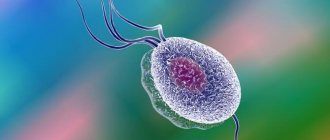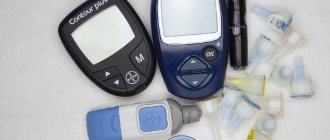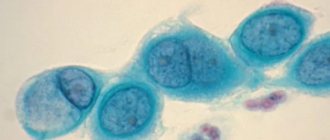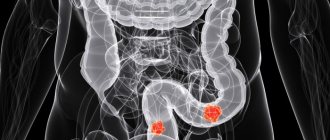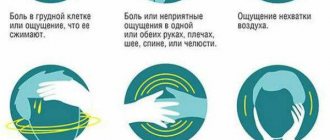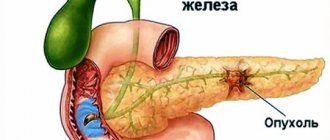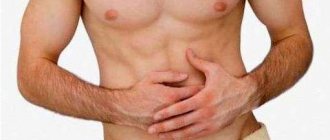First signs: how to identify hemorrhoids in women?
The main cause of hemorrhoids is dysfunction of the veins in the anorectal area. When the vein passing under the mucosa is deformed, nodes form inside, in close proximity to the sphincter. They greatly narrow the lumen of the rectum, preventing the passage of feces, causing constant constipation and internal microdamage.
The onset of the disease is almost asymptomatic. Patients complain of general malaise, periodic fever, pain during bowel movements. Sometimes traces of fresh blood are found on toilet paper.
Most women do not go to the doctor, believing that such manifestations will go away on their own. However, untimely treatment leads to a transition from the acute phase to the chronic phase ; treating an advanced disease is much more difficult.
What symptoms may indicate hemorrhoids?
Possible complications of the disease
Without treatment, serious consequences develop:
- Thrombosis. Blood clots appear in the veins, which compress the nerve endings. The nodules swell, become cyanotic, and the pain intensifies.
- Sphincter weakness. The anal valve ceases to contain the contents of the intestines, gases, liquid feces leak out.
- Nodule pinching. When lifting weights or after visiting the toilet, the lump falls out and is compressed by the sphincters of the anal passage. This phenomenon is accompanied by sharp pain, the node turns blue, and the surrounding tissues swell and turn red.
- Anemia. Constant bleeding of the corpus cavernosum leads to a drop in hemoglobin levels, which affects well-being and suppresses the immune system.
If an infection penetrates the perianal area, purulent tissue inflammation develops over time - parapraktitis.
Stages of manifestation and symptoms
At the initial stage of internal hemorrhoids, the following symptoms appear:
- general malaise;
- constipation alternating with diarrhea;
- burning and itching in the anus;
- short-term increase in temperature.
Unpleasant sensations are associated with visiting the toilet; pain and itching go away at rest. Nodes on the veins are hardly noticeable; they can only be detected using intrarectal examinations using an anoscope or ultrasound.
In the second stage, the symptoms become more pronounced:
- pain during bowel movements increases;
- traces of blood are visible on linen and toilet paper;
- bloody streaks appear in the stool;
- severe itching is felt in the anal area;
- after visiting the toilet there is a feeling of incomplete bowel movement;
- Mucus is secreted from the anus, causing skin irritation.
When you insert your finger inside the anus, you can feel small, painless lumps that narrow the lumen of the rectum.
In the absence of adequate treatment, the disease develops. At stage 3, the patient’s condition worsens:
- pain becomes constant;
- there is a constant burning and itching in the anal area;
- possible ruptures at the junction of the skin and mucous membrane (anal fissures);
- blood mixed with pus flows from the anus;
- Severe swelling occurs in the anus area, making it difficult to sit and move freely;
- overgrown nodes make defecation painful, every visit to the toilet is associated with extensive ruptures of the mucous membrane;
- enlarged bumps are noticeable in the anus and can be easily felt with a finger.
The third stage requires immediate treatment; usually the doctor insists on immediate surgery or a long course of antibiotics. In the absence of intervention, anemia may develop, purulent fistulas form on the skin, and tissue death begins.
One of the most striking symptoms is pain in the anus. In the initial stage, the patient feels it during bowel movements.
As hemorrhoids grow, the mucous membrane is constantly damaged, and ruptures do not heal for a long time.
Large lumps put pressure on the nerve endings , and as a result, every trip to the toilet turns into torture.
During the day, the pain changes from acute (during defecation and immediately after it) to dull and aching (at rest). When inflammation and purulent fistulas appear, the patient feels a burning sensation, the pain becomes throbbing and is accompanied by an increase in temperature.
As the disease enters the chronic phase, attacks of pain may alternate with periods of rest. With the development of hemorrhoids, the remission time is shortened, the patient experiences discomfort with every movement. In phases 3 and 4, she cannot sit or walk normally ; coughing, sneezing or laughing causes sharp stabbing pain. It is felt in the anus, radiates to the stomach, lower back, and thighs.
Stages of hemorrhoids
Features of internal hemorrhoids
Internal hemorrhoids are a disease characterized by the formation of various seals and nodes in the deep layers of the rectum.
At an early stage, the muscle wall weakens in the blood vessels, which are found in large numbers in the rectum. As a result, small expansions are formed.
At the second stage, there is a significant increase in varicose veins, which, in turn, is a big problem during bowel movements. At this stage, the clinical picture has a wave-like character, the symptoms of exacerbation are replaced by periods of noticeable improvement. Although the feeling of discomfort in the anus does not disappear.
The third stage is called chronic. It is characterized by progression of the inflammatory process. Large varicose tumors can be visually identified.
The course of the disease becomes more complicated, the symptoms become more and more pronounced, and varicose veins tend to fall out during bowel movements.
At the final stage of hemorrhoids, it is necessary to take prompt measures aimed at eliminating varicose veins. The slightest delay will lead to complications that threaten your health.
Today, medicine distinguishes several causes and factors that favor the development of internal hemorrhoids.
Most often, pathology occurs as a result of:
- Lack of a healthy and balanced diet. Abuse of salty, smoked foods, as well as various sweets with relatively little use of vegetables, fruits and grains in the diet can lead to constipation. At first glance, a relatively harmless condition leads to the fact that the blood vessels in the rectal area are subjected to great pressure, which leads to stagnant processes, and then directly to pathology.
- Passive lifestyle. Modern realities are designed in such a way that instead of dynamic and active recreation, people prefer to stay at home and spend time watching TV. Office work and long periods of driving can cause blood to stagnate in the veins of the pelvis.
- Physical overexertion. Often it is inadequate physical activity in the form of heavy lifting that is a classic factor that increases the likelihood of developing the disease. It is not surprising that the risk category is made up of athletes who lift heavy weights.
- Bearing a child and giving birth. Due to the physiological characteristics of a woman’s body, both during pregnancy and after it, circumstances arise that increase the load on the inner surface of the pelvic vessels. As a result, internal hemorrhoids develop.
We should also not forget that drinking alcohol leads to dilation of blood vessels and, accordingly, an increase in blood flow. And this negatively affects the vascular wall.
In a sluggish process, when the symptoms do not cause much discomfort to a person, drinking alcohol, smoking a cigarette, obesity or prolonged emotional stress can serve as a trigger that will provoke activation of the inflammatory process.
What does inflammation of the internal nodes look like?
In the internal form of the disease, the nodes are located inside the anus and are practically invisible during external examination. The problem can be detected by palpation or internal examination using an anoscope. Protrusions on the mucous membrane resemble single large lumps or a cluster of small nodules, which feel painful when pressed.
At stages 2 and 3, anal fissures may appear - tears at the border of the skin and mucous membrane. At first they resemble ordinary wounds, but gradually the edges scar and diverge.
With severe stress or mechanical damage, the cracks begin to bleed. Swelling occurs in the anal area, the skin turns red and peels. Weeping wounds, irritations, and small ulcers are possible.
During pregnancy, a combined form of hemorrhoids is more common , when internal nodes are complemented by external ones. They protrude from the anus after defecation; at stage 3, the bumps have to be reset manually.
Possible consequences of the disease in women
As mentioned above, untimely and incorrect treatment can lead to the development of complications that are much more difficult to eliminate. Possible consequences of hemorrhoids in women include:
- Polyps that can form in the colon. Moreover, they will not make themselves felt, and they can only be detected during a routine inspection
- Cancer, since during hemorrhoids the structure of the mucous membrane and cells changes, the body is forced to fight infection, and this can be very stressful
- Colitis, the main symptoms of which are diarrhea and abdominal pain. It is colitis that develops parallel to hemorrhoids, and it is not always possible to recognize it at the very initial stage
- Constipation. This is one of the causes of hemorrhoids, and also its consequences. When hemorrhoids swell, the process of defecation becomes difficult, and it is more difficult for stool to pass through the intestines
- Cracks, which are an excellent place for bacteria to multiply and, as a result, penetrate into the body
- Cryptit. Because of this disease, the risk of developing malignant tumors increases many times.
Read: Internal hemorrhoids: causes, symptoms, treatment
As for pregnant women, they suffer the most. Not only is your health not good enough to lead an active lifestyle. But when pain and problems with bowel movements are added to this, it upsets many. In addition, untreated hemorrhoids significantly prolong the postpartum period, since in addition to ruptures that occurred during childbirth, there are other problems.
Photo of the disease
Treatment methods: what to bet on?
When treating internal hemorrhoids, an integrated approach is recommended. The doctor selects the therapeutic regimen. At the first stage, light ventilating and restorative drugs, laxative suppositories, and vitamin complexes are prescribed.
At stages 2 and 3, potent drugs with a regenerating, anti-edematous, antibacterial and anti-inflammatory effect are needed. Severe forms require surgery followed by a course of antibiotics.
Conservative therapy
- In the initial and middle stages, venotonic drugs help well. Most often, patients are prescribed Detralex, Venarus or Phlebodia, which strengthen the walls of blood vessels, improve blood flow and prevent the proliferation of nodes.
- Candles are used to relieve pain and eliminate internal damage. In case of advanced form or severe attacks, Ultraproct suppositories will help. Homeopathic suppositories Hemorol have a good healing and venotonic effect. They contain plant extracts of chamomile, horse chestnut seeds, gorse, yarrow, and belladonna.
- For internal hemorrhoids, treatment with ointments is indicated. They relieve swelling of the anus, eliminate damage to the mucous membrane, and calm bleeding. It is better to choose drugs that can be injected into the anus using a special plastic tip. The drugs from the Relief series, Gepatrombin G, and Troxevasin have a good healing effect.
Surgical intervention
Minimally invasive techniques are actively used to treat stage 2 and 3 internal hemorrhoids. They allow you to get rid of large painful nodes on an outpatient basis. Some types of interventions are performed without anesthesia , others are performed under local anesthesia.
Among the most popular options:
- ligation with latex rings;
- cryotherapy;
- sclerotherapy;
- disarterization.
The choice of method depends on the degree and characteristics of hemorrhoids, as well as on the general condition of the patient. For example, with large single nodes, ligation helps well. Using an anoscope, a latex ring is placed on the base of the cone, which is tightened and cuts off the supply to the node. After a few days it dies and is excreted from the body.
For minor, subtle vein deformities, sclerotherapy is indicated. An adhesive substance is injected into the vessels, stopping the flow of blood and directing it into a different direction. Disarterization has worked well.
Using an anoscope, the arteries supplying the hemorrhoids are ligated, after which the cones die.
For stages 3 and 4 hemorrhoids, the doctor may recommend a classic hemorrhoidectomy. The nodes are excised using a laser, followed by suturing the wounds or without it. The procedure is performed in a hospital under general anesthesia. After it, a long recovery is required; in case of inflammation, a course of antibiotics is prescribed.
Folk remedies
Traditional medicine methods can alleviate the patient’s condition. They should be used with caution, after consulting with your doctor. For the internal form of the disease they help:
- microenemas with herbal decoctions;
- homemade candles;
- soothing baths;
- strengthening and restorative infusions.
Dry or freshly picked herbs are used for baths and enemas: chamomile, yarrow, nettle, wormwood, sage, string, horse chestnut, calendula, eucalyptus and laurel leaves. Aloe juice lotions are useful.
To prepare a basic decoction, a handful of raw materials is poured into 1 liter of boiling water, heated in a water bath, infused under a lid and filtered. To take baths, the decoction is diluted with 2 liters of warm or cool water and poured into a basin. The procedure lasts 5-10 minutes.
For microenemas, 50 ml of decoction is enough, which is injected into the rectum using a syringe.
The decoction can be frozen in blisters of ready-made suppositories to make ice suppositories that are good for relieving swelling and pain. They are administered for 3 minutes 2-3 times a day. Candles can also be made from unsalted pork fat by mixing it with heated propolis, honey, or a decoction of calendula or chamomile.
The treatment will be completed by taking medicinal decoctions internally. A mixture of dry chamomile, horse chestnut seeds, sage and nettle will help relieve inflammation. The decoction is taken 3 times a day before meals, a single dose is 0.25 cups.
Types, forms and stages of hemorrhoids
Depending on the location of the pathological process, hemorrhoids can be external, internal or combined. According to its course, it is divided into acute and chronic. In clinical practice, it is customary to consider 4 stages of the disease:
Stage I. It is characterized by swelling and bulging of captive, sometimes bleeding hemorrhoids. There is an increase in the vascular pattern of the mucous membrane, as well as minor anatomical changes in the longitudinal muscle.
Stage II. There is an increase and loss of nodes, which are automatically retracted into the anal canal, mucous discharge and itching appear; histological examination reveals mild degeneration in the fibromuscular framework with a predominance of the number of elastic fibers.
Stage III. It occurs against the background of increasing anal itching and frequent bleeding. Prolapsed hemorrhoids require manual or instrumental reduction. Laboratory studies reveal morphological changes in muscle tissue, indicating the predominance of dystrophic processes and loss of elasticity.
Stage IV. It is characterized by constant bleeding from hemorrhoids that cannot be reduced, severe pain and incontinence of the anal sphincter, indicating complete degeneration of the fibromuscular frame.
The most typical location of hemorrhoidal “bumps” is the right anterior, posterior, and left lateral walls of the rectal canal.
Features of the fight against illness during pregnancy
- During pregnancy, you need to be especially careful when choosing medications. Patients are contraindicated with drugs containing belladonna, which causes contractions of the uterine muscles. Do not use large amounts of painkillers. Lotions made from chamomile decoction or suppositories with lidocaine, which do not have a harmful effect on the body, will help soothe unpleasant sensations.
- Treatment with antibiotics is possible only in extreme cases and under constant medical supervision. Antibacterial solutions, for example Miramistin, will help relieve local inflammation. The product can be injected into the rectum using a syringe or used as a lotion.
- Many traditional medicine methods are unsafe for pregnant women. You should avoid warm baths and limit yourself to lotions. Hot compresses and ice suppositories are contraindicated.
- Pregnant women need to watch their diet to reduce the risk of constipation. The menu includes more fiber. Fresh vegetables and fruits, low-fat dairy products. If you have constipation, you should not take laxatives; it is better to use suppositories with glycerin or papaverine, which provide not only a laxative, but also a mild analgesic effect.
It is important to see a doctor in time. Only a specialist can draw up the correct therapeutic program.
Timely diagnosis and proper treatment of internal hemorrhoids is the key to long-term remission and subsequent cure.

